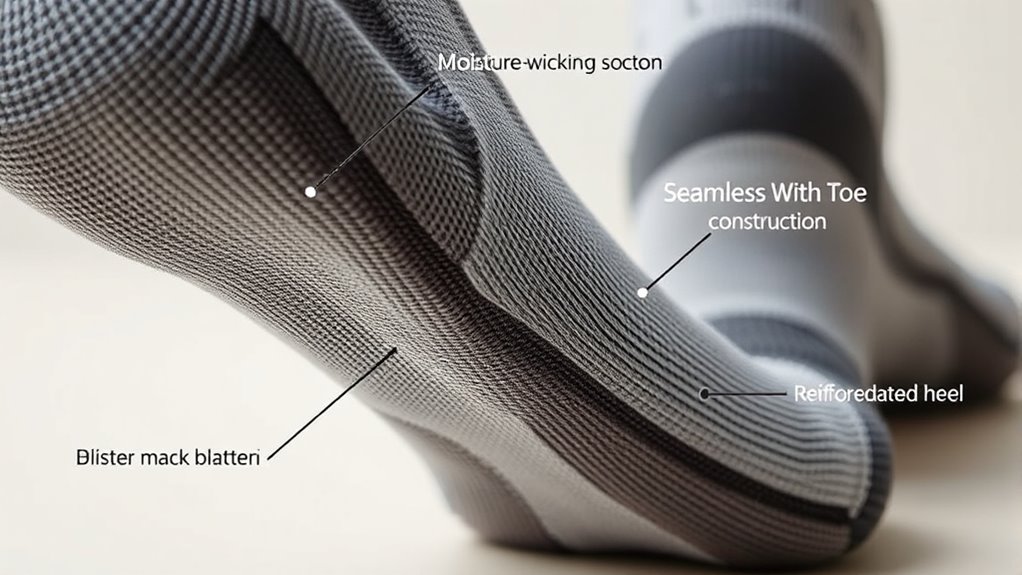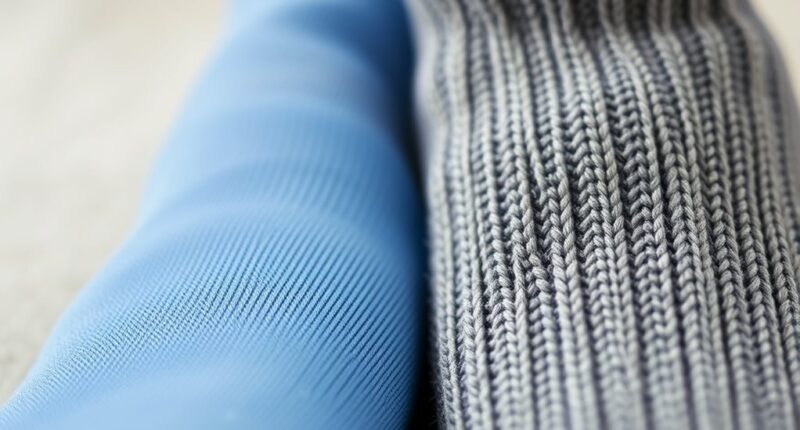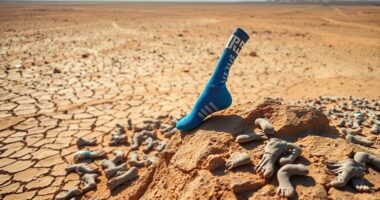Choosing the right sock fabric is key for blister prevention. Look for materials with moisture-wicking properties like polyester, nylon, or synthetic blends, as they pull sweat away from your skin and keep your feet dry. Durability is also important—opt for reinforced areas and fabrics that resist wear. Tighter weaves and thicker fabrics can reduce friction and blister risk, especially during intense activity. Keep exploring to discover more tips for staying blister-free and comfortable.
Key Takeaways
- Choose moisture-wicking fabrics like polyester or synthetic blends to keep feet dry and reduce blister risk.
- Opt for socks with a tight weave to minimize friction and prevent blisters caused by rubbing.
- Reinforced heel and toe areas enhance durability and reduce pressure points that can lead to blisters.
- Thicker fabrics provide extra padding, offering cushioning for high-impact activities and blister prevention.
- Proper sock fit and selecting breathable, moisture-wicking materials are essential for maintaining foot health and blister prevention.

Have you ever wondered what makes a sock comfortable and durable? The answer lies in understanding the fabric it’s made from. The right sock fabric can substantially reduce the risk of blisters and keep your feet feeling fresh, even during intense activities. One of the key features to look for is moisture-wicking properties. These fabrics are designed to pull sweat away from your skin, allowing it to evaporate quickly. When your feet stay dry, you’re less likely to experience friction that causes blisters. Materials like polyester, nylon, and specialized synthetic blends excel at moisture management, making them excellent choices for activewear or daily use. They help maintain a comfortable environment inside your shoe, preventing dampness that can lead to skin irritation.
But moisture-wicking isn’t the only factor to contemplate. Durability factors also play a vital role in sock performance. You want a fabric that can withstand repeated wear and washing without losing its shape, elasticity, or protective qualities. Natural fibers like wool or cotton may feel soft and breathable at first, but they tend to wear out faster and may retain moisture longer, which isn’t ideal for blister prevention. Synthetic fibers, on the other hand, often come with added durability factors such as reinforced heel and toe areas, which are high-stress zones prone to wear and tear. These reinforced areas help your socks last longer and maintain their protective function over time.
Choosing a sock fabric with the right balance of moisture-wicking properties and durability factors means you’ll stay comfortable and blister-free for longer periods. It’s about finding that perfect combination that keeps your feet dry, cushions pressure points, and resists the rigors of regular use. Also, consider the weave and thickness of the fabric. A tighter weave can prevent friction and reduce blister formation, while thicker fabrics provide extra padding for high-impact activities. Ultimately, your choice of sock fabric should align with your activity level and foot care needs. For runners, hikers, or anyone on their feet all day, investing in high-quality synthetic blends with proven moisture-wicking and durability features can make a noticeable difference in preventing blisters and maintaining foot health. Remember, the right fabric is your first line of defense against foot discomfort and injury.
Frequently Asked Questions
How Do Sock Fabrics Affect Moisture-Wicking Performance?
Sock fabrics greatly influence moisture-wicking performance by their fiber breathability and moisture management abilities. When you choose socks with breathable fibers, they allow heat and sweat to escape, keeping your feet dry. Effective moisture management wicks sweat away from your skin, preventing blisters and discomfort. Opt for fabrics designed for ideal breathability and moisture control, ensuring your feet stay dry and comfortable during any activity.
Are Synthetic or Natural Fibers Better for Blister Prevention?
Imagine you’re stepping into a high-tech cockpit—synthetic fibers often outperform natural ones for blister prevention. They offer better fiber elasticity and fabric breathability, which keeps your feet dry and reduces friction. Natural fibers like cotton tend to trap moisture, increasing blister risk. So, choose synthetic socks for active days, as they adapt better to your foot’s movements and help prevent blisters by staying dry and comfortable.
Can Sock Fabric Type Influence Foot Temperature Regulation?
Yes, sock fabric type can influence foot temperature regulation. You’ll find that breathable fabrics like merino wool or synthetic blends with moisture-wicking properties help maintain thermal regulation by allowing air flow and moisture management. These materials prevent overheating and excessive sweating, keeping your feet comfortable during activity. Choosing the right fabric enhances breathability, which in turn helps regulate foot temperature, reducing discomfort and the risk of blisters caused by moisture buildup.
How Does Fabric Weave Impact Sock Durability and Blister Prevention?
The fabric weave directly impacts sock durability and blister prevention by influencing fiber elasticity and fabric breathability. A tighter weave enhances durability, making socks more resistant to wear and tear, while also reducing friction against your skin. Breathable weaves allow moisture to escape, keeping your feet dry and less prone to blisters. Choose socks with a balanced weave to maximize both durability and blister prevention, ensuring comfort during extended wear.
Do Different Sock Fabrics Require Special Washing Instructions?
Did you know that improper sock fabric care can reduce their lifespan by up to 50%? Different sock fabrics, like wool or synthetic blends, need specific washing sock materials instructions. Always check labels, as some require cold water or gentle cycles. Wool, for example, often needs hand washing or a delicate cycle, while synthetic fabrics usually handle machine washes well. Proper washing sock materials guarantees your socks stay comfortable and blister-free longer.
Conclusion
Now that you know the basics of sock fabrics, you can picture your feet wrapped in the perfect blend—breathable cotton, moisture-wicking polyester, or cozy wool—each one fighting off blisters like a loyal shield. Imagine your steps on a chilly trail, your socks working silently beneath, keeping your feet dry and comfortable. With the right fabric, every stride feels lighter, safer, and more confident. So, choose wisely, and let your feet enjoy the journey ahead.








